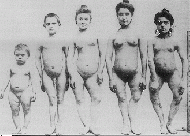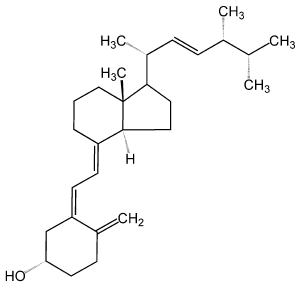Rickets
| Rickets Classification and external resources | ||
| A family with rickets. Paris, 1900. | ||
| ICD-10 | E55 | |
| ICD-9 | 268 | |
| DiseasesDB | 9351 | |
| MedlinePlus | 000344 | |
| eMedicine | ped/2014 | |
| MeSH | D012279 | |
Rickets is a softening of the bones in children potentially leading to fractures and deformity. Rickets is among the most frequent childhood diseases in many developing countries. The predominant cause is a vitamin D deficiency, but lack of adequate calcium in the diet may also lead to rickets. Although it can occur in adults, the majority of cases occur in children suffering from severe malnutrition, usually resulting from famine or starvation during the early stages of childhood. Osteomalacia is the term used to describe a similar condition occurring in adults, generally due to a deficiency of vitamin D.[citation needed] The word "rickets" comes from the word "rachitis," meaning wrist (and also spine), as wrist deformities are common and obvious in rickets.
Epidemiology
Those at higher risk for developing rickets include:
- Dark-skinned children
- Breast-fed infants whose mothers are not exposed to sunlight
- Breast-fed infants who are not exposed to sunlight
- Individuals not consuming fortified milk, such as those who are lactose intolerant
Individuals with red hair (who also generally have extremely pale skin that burns rather than tans) have a decreased risk for rickets due to their greater production of vitamin D in sunlight.[1]
Etiology
Vitamin D is required for proper calcium absorption from the gut. In the absence of vitamin D, dietary calcium is not properly absorbed, resulting in hypocalcemia, leading to skeletal and dental deformities and neuromuscular symptoms, e.g. hyperexcitability.
A rare X-linked dominant form exists called Vitamin D resistant rickets.
Presentation
Signs and symptoms of rickets include:
- Bone pain or tenderness
- dental problems
- muscle weakness (rickety myopathy or "floppy baby syndrome")
- increased tendency for fractures (easily broken bones), especially greenstick fractures
- Skeletal deformity
- Toddlers: Bowed legs (genu varus)
- Older children: Knock-knees (genu valgus) or "windswept knees"
- Cranial, spinal, and pelvic deformities
- Growth disturbance
- Hypocalcemia (low level of calcium in the blood), and
- Tetany (uncontrolled muscle spasms all over the body).
- Craniotabes (soft skull)
- Costochondral swelling (aka "rickety rosary" or "rachitic rosary")
- Harrison's groove
- Double malleoli sign due to metaphyseal hyperplasia [1]
An X-ray or radiograph of an advanced sufferer from rickets tends to present in a classic way: bow legs (outward curve of long bone of the legs) and a deformed chest. Changes in the skull also occur causing a distinctive "square headed" appearance. These deformities persist into adult life if not treated.
Long-term consequences include permanent bends or disfiguration of the long bones, and a curved back.
Diagnosis
A doctor may diagnose rickets by:
- Blood tests:
- Serum calcium may show low levels of calcium, serum phosphorus may be low, and serum alkaline phosphatase may be high.
- Arterial blood gases may reveal metabolic acidosis
- X-rays of affected bones may show loss of calcium from bones or changes in the shape or structure of the bones.
- Bone biopsy is rarely performed but will confirm rickets.
Treatment and prevention
Diet and sunlight
Treatment involves increasing dietary intake of calcium, phosphates and vitamin D. Exposure to ultraviolet in sunshine, cod liver oil, halibut-liver oil, and viosterol are all sources of vitamin D.
A sufficient amount of ultraviolet in sunlight each day and adequate supplies of calcium and phosphorus in the diet can prevent rickets. Darker-skinned babies need to be exposed longer to the ultraviolet rays. The replacement of vitamin D has been proven to correct rickets using these methods of ultraviolet light therapyand medicine.
Recommendations are for 200 international units (IU) of vitamin D a day for infants and children. Children who do not get adequate amounts of vitamin D are at increased risk of rickets. Vitamin D is essential for allowing the body to uptake calcium for use in proper bone calcification and maintenance.
Supplementation
Sufficient vitamin D levels can also be achieved through dietary supplementation. Vitamin D3 (cholecalciferol) is the preferred form since it is more readily absorbed than vitamin D2. Most dermatologists recommend vitamin D supplementation as an alternative to unprotected ultraviolet exposure due to the increased risk of skin cancer associated with sun exposure.
According to the American Academy of Pediatrics (AAP), infants who are breast-fed may not get enough vitamin D from breast milk alone. For this reason, the AAP recommends that infants who are exclusively breast-fed receive daily supplements of vitamin D from age 2 months until they start drinking at least 17 ounces of vitamin D-fortified milk or formula a day.[citation needed]
ReferencesISBN links support NWE through referral fees
External links
- Dr. Susan Ott's website on osteomalacia
- Rickets - Symptoms, Causes, Treatment
- Dictionary.com - Osteomalacia
- Fluoride & Osteomalacia
- History of Vitamin D and the battle against Rickets
- Template:Chorus
Credits
New World Encyclopedia writers and editors rewrote and completed the Wikipedia article in accordance with New World Encyclopedia standards. This article abides by terms of the Creative Commons CC-by-sa 3.0 License (CC-by-sa), which may be used and disseminated with proper attribution. Credit is due under the terms of this license that can reference both the New World Encyclopedia contributors and the selfless volunteer contributors of the Wikimedia Foundation. To cite this article click here for a list of acceptable citing formats.The history of earlier contributions by wikipedians is accessible to researchers here:
The history of this article since it was imported to New World Encyclopedia:
Note: Some restrictions may apply to use of individual images which are separately licensed.


